 Hearing With Two Ears
Hearing With Two Ears
Binaural Hearing. “We have two ears and one mouth so that we can listen twice as much as we speak” (Epictetus the Stoic).
These may be wishful thoughts relative to wisdom, but near the truth relative to psychoacoustics. The auditory system maximizes slight differences in time (and phase), intensity, and spectral composition between acoustic stimuli arriving at the ears, enabling the brain to perceive auditory space fully. Additionally, factors such as masking differences, the absorption and reflection characteristics of the environment, and the practical significance of various sounds also operate.
Many variables must interact in a complex way for sounds to be perceived with two ears (binaurally).
How Sound is Received by the Ears
How sound is received by the ears can be described as (Figure 1):
- Monotic – one signal to one ear, as listening with a single earphone/earbud
- Diotic – one signal to two ears, as listening with an earphone/earbud to each ear
- Dichotic – one complete amplification system to one ear and a second complete amplification system to the other ear (as common with hearing aids, resulting in what is called binaural amplification)
- Binaural – a general term literally translated as “having or related to two ears.” Its counterpart, when generally translated to having or related to one ear, is termed monaural.
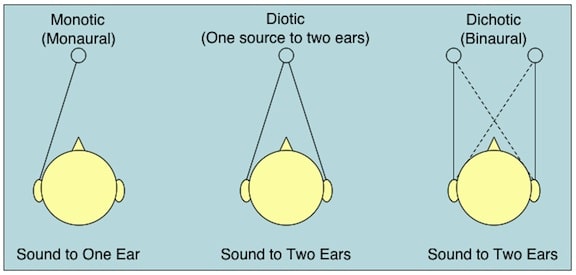
Figure 1. Modes of amplified sound directed to the ears, as when listening with hearing aids or earphone listening devices. In monotic, the signal could be directed to either ear, even if the source was multiple. Diotic reception occurs when a sound source is split and is directed to both ears. Dichotic reception occurs when different messages are transmitted into each ear. If the ears are unoccluded (open, as in normal listening), the arrangement for each of these would result in binaural listening where the sound sources are received by both ears.
In normal hearing situations, sound waves reaching the ears differ in:
- Their intensities
- The time at which each ear receives corresponding portions of the sound waves
- Their spectral compositions (waveforms)
Practical Advantages of Hearing With Two Ears
Practical advantages of hearing binaurally occur almost exclusively when listening in competing sounds. The following are among the major phenomenon involved:
- Head shadow effect
- Sound localization
- Loudness squelch
- Facilitation in noise (masking level difference)
- Binaural summation
Head Shadow Effect
The head shadow effect refers to the phenomenon where the head acts as a barrier to sound waves, causing a reduction in the intensity of sound reaching the opposite ear. This effect is particularly pronounced for high-frequency sounds and plays a crucial role in sound localization and the ability to perceive sound direction.
In other words, the head shadow refers to the reduction in the intensity of sound as it crosses from one side of the head to the other (Figure 2). When a sound crosses from one ear to the other, at least three things happen:
- The signal strength is modified
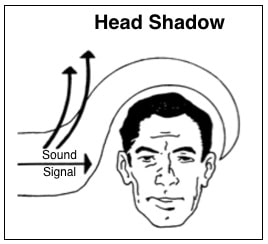
Figure 2. Head shadow effect results from the interpositioning of the head to a sound source. The effect is that high-frequency sounds having short wavelengths will have the signal reduced by as much as 15 dB (head shadow), while low frequencies with longer wavelengths with respect to the size of the object in the path (head) will readily pass around the object (essentially no head shadow).
- There is a change in the spectral pattern, and
- A time of arrival (and hence phase) change occurs
Modification of intensity level
This is related to the azimuth factor – direction from which the sound comes. For speech in general, it is essentially the high frequencies that are reduced in signal strength. High-frequency sounds have short wavelengths with respect to the size of the object (head), meaning that they meet substantial resistance in passing from one side of the head to the other. The high-frequency signal can be reduced by as much as 15 dB due to the head shadow. Low-frequency sounds, on the other hand, have longer wavelengths with respect to the size of the object in the path (head), and will readily pass around the object (little or no head shadow).
Spondees (two syllable words having equal stress on each syllable – cowboy, inkwell, toothbrush, etc.), can lead to a 6.4 dB reduction in signal strength in that received at a 450 azimuth to the direct ear (Figure 3).

Figure 3. Effect of head shadow on the intensity level at the near and far ears when the speech signal is directed to the near ear at 450.
It is easy to see that the head shadow can result in a double effect in everyday listening. Assume that unwanted conversation is coming to the left while the speech of interest is coming from the right (Figure 4). Assume also that without the head that they would be equal in strength (S/N = 0).
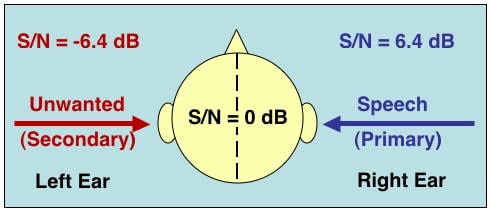
Figure 4. Head shadow, double effect.
With a head inserted, the unwanted communication would be attenuated in passing to the right ear, but the wanted conversation is not attenuated on that side. This would result in an effective signal-to-noise ratio (or primary-to-secondary ratio) of 6.4 to the right ear. This would be reversed on the opposite ear (-6.4), resulting in an approximate 13 dB ratio difference between the two ears. In other words, the masking effect of the unwanted conversation would be about 13 dB less severe on the right ear merely because of the sound source locations relative to the head.
An unfavorable condition created by head shadow is shown in Figure 5. This occurs when noise is presented to the better and/or aided ear, while the primary intended signal is directed to the poor, or unaided ear.
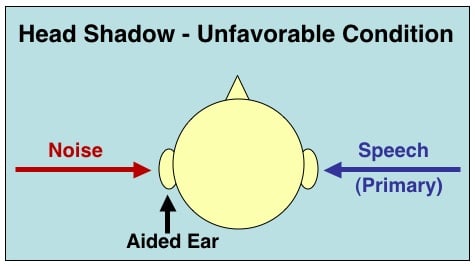
Figure 5. Unfavorable condition created by head shadow when the desired sound is on the wrong side of the head, but noises are not, leading to an unfavorable balance between important messages and background noises.
Head shadow cannot be escaped in everyday listening in that one ear is always better situated than the other, leading to a more favorable signal-to-noise (S/N) balance. This means that one ear momentarily receives a greater amount of useful information than the other. As such, even in binaural hearing, the listening advantage shifts between the ears on an ongoing basis. Carhart (1967) reports, “there is much more of this type of ‘one-eared’ listening than is usually recognized.”
At times, especially in noisy environments, masking can be reduced by deliberately rotating one ear toward the primary sound in an attempt to maximize the head shadow effect. This is an example of primarily relying on one ear to facilitate understanding by improving the S/N ratio. However, this practice is not always practical.
Changes in spectral pattern
A sound spectrum is a graphic display of the energy distribution along a frequency scale for a particular sound. A simple example is shown in Figure 6 for three different vowel sounds. Sound spectra will change constantly as the distance, direction, diffraction of the signal by head shadow, and level of the sound that reaches the ears changes.
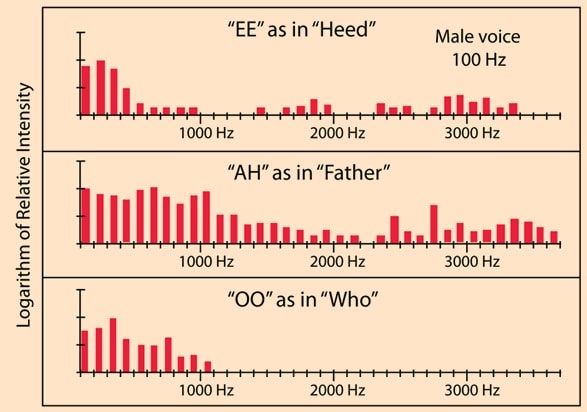
Figure 6. Sound spectra of three different vowel sounds, showing the energy by frequency that distinguishes them from each other, even though spoken by the same individual.
When the sound source changes directions, the spectral balance between the ears changes. However, it will not be the same at the ears because of head diffraction influences unless the sounds are initiated by the same location. Interestingly, these changes in spectral pattern, leading to dissimilarities in balance between the ears, can provide additional clues to increase the efficiency of binaural hearing. This may be due to the ability of the listener to perform useful cross-correlation of incoming information to the auto-correlation that each incoming signal train undergoes separately. And, this binaural advantage is most likely to manifest itself when competing sounds are present. This is because masking of the far ear deprives the channel served by the near ear of the full information that would have otherwise been available to it. As a result, the far ear seems to supply enough added information to improve the speech perception slightly (Carhart, 1967). This is despite the fact that head shadow increased masking in the far ear.
(Next week’s post will continue this discussion of binaural hearing and how it relates to localization of sounds).
References:
- Tillman, T, Kasten, R., and Horner, J. Effect of head shadow on reception of speech. Paper for 1963 Convention of American Speech and Hearing Association. Abstract in ASHA. 5:778, 1963.
- Carhart, R. (1967). Binaural reception of meaningful material. In A.B. Graham (Ed.) Sensorineural Hearing Processes and Disorders, Brown and Co., Boston, MA
- https://hyperphysics.phy-astr.gsu.edu/hbase/sound/vowel.html
- Cherry, E.C., and Sayers, B. McA. (1956). Human ‘cross-correlator’ – a technique for measuring certain parameters of speech perception. J. Acoust. Soc. Am., 28, 889
Wayne Staab, PhD, is an internationally recognized authority in hearing aids. As President of Dr. Wayne J. Staab and Associates, he is engaged in consulting, research, development, manufacturing, education, and marketing projects related to hearing. His professional career has included University teaching, hearing clinic work, hearing aid company management and sales, and extensive work with engineering in developing and bringing new technology and products to the discipline of hearing. This varied background allows him to couple manufacturing and business with the science of acoustics to bring innovative developments and insights to our discipline. Dr. Staab has authored numerous books, chapters, and articles related to hearing aids and their fitting, and is an internationally-requested presenter. He is a past President and past Executive Director of the American Auditory Society and a retired Fellow of the International Collegium of Rehabilitative Audiology.
**this piece has been updated for clarity. It originally published on February 10, 2015






